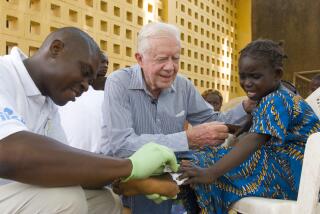U.S. Leprosy Treatment Center Turns 100 : Medicine: Hospital devoted solely to Hansen’s disease is one of the world’s leading research facilities. On centennial, it’s hailed as ‘stunning success story.’
- Share via
WASHINGTON — One hundred years ago today, five men and two women were secretly transported by barge up the Mississippi River to an abandoned Louisiana plantation.
The seven were suffering from leprosy, one of the most feared and loathed conditions of the time. And the plantation was to become the one hospital in the United States devoted solely to treating the disease and to offering a long-term sanctuary to its patients.
Today, Hansen’s disease--as it is now known--can be treated and cured, and the once powerful stigma associated with it has been substantially diminished. Only about 130 patients--most of them elderly, with no place else to go--still call the center their home and a mere 6,000 patients in the United States are affected by the disease.
Nevertheless, the century-old facility in Carville, La., which is run by the U.S. Public Health Service’s Health Resources and Services Administration, is suddenly enjoying renewed attention because of its age-old research techniques.
The knowledge gained from studying and treating Hansen’s disease, which is caused by a bacterium, now appears to have widespread application to other illnesses, including diabetes and tuberculosis.
Federal health officials have called the work of the center a “stunning success story” in the public health arena. Renamed the Gillis W. Long Hansen’s Disease Center in 1985 after the congressman who helped keep it open, the facility celebrates its centennial this week.
Thursday and Friday, experts from around the world are scheduled to commemorate the anniversary with a meeting in Baton Rouge to share the latest research information on Hansen’s disease.
“Since the discovery for a clinical cure for Hansen’s disease . . . the center has become one of the world’s leading international research centers and now contributes to progress in the treatment of other diseases,” said Dr. Philip R. Lee, assistant Health and Human Services secretary and head of the U.S. Public Health Service.
Hansen’s disease is an infectious condition that affects the skin, nerves and eyes. If left untreated, it can lead to muscle deformity, bone infection, loss of sensation in extremities--sometimes even paralysis--and blindness.
Although an estimated 2.4 million persons worldwide have the disease, last year for the first time the incidence of new cases began to drop and the World Health Organization is hopeful that Hansen’s will be under control by the year 2000.
It is not considered life-threatening, although serious cases can cause major deformities, which are permanent. Lack of sensation in hands and feet, for example, can result in neglect of repeated injuries to those areas of the body, leading to infections and, ultimately, to bone destruction.
Hansen’s is treated with a combination of two or three antibiotics for different periods of time, depending on its severity.
The first drugs to treat it were identified in 1941, marking “the beginning of the end to the agonizing stigmatization surrounding this condition,” said Dr. Ciro Sumaya, Health Resources and Services administrator. “Patients no longer would have to enter an isolated world.”
Dr. Robert Jacobson, director of the center, said the disease can be treated and cured but “damage caused by the disease will remain. Nowadays, when the diagnosis is made earlier, we’re seeing less deformities than in the past.”
It is considered “mildly” infectious because “95% of the population does not appear to be susceptible to it,” Jacobson said. “Those who get it seem to have a defect in their immune response,” which could be inherited.
Although its exact mode of transmission has never been confirmed, Hansen’s is believed to be passed through the respiratory system by coughing and inhalation.
Because the bacterial agent that causes Hansen’s (Mycobacterium leprae) is so closely related to the one responsible for tuberculosis (Mycobacterium tuberculosis) , researchers at the Carville facility increasingly have been called upon to apply their expertise to combatting TB.






